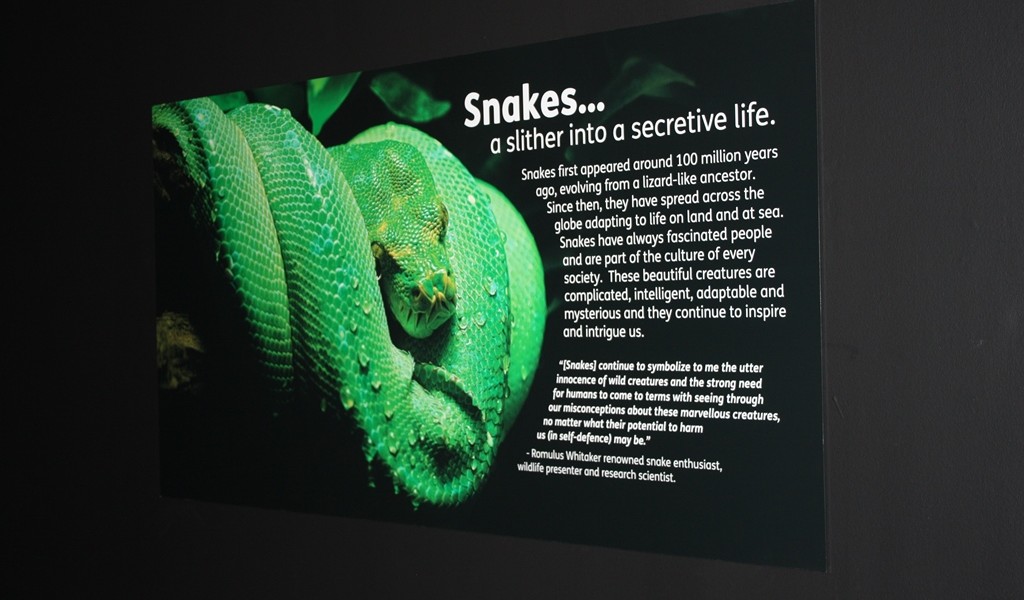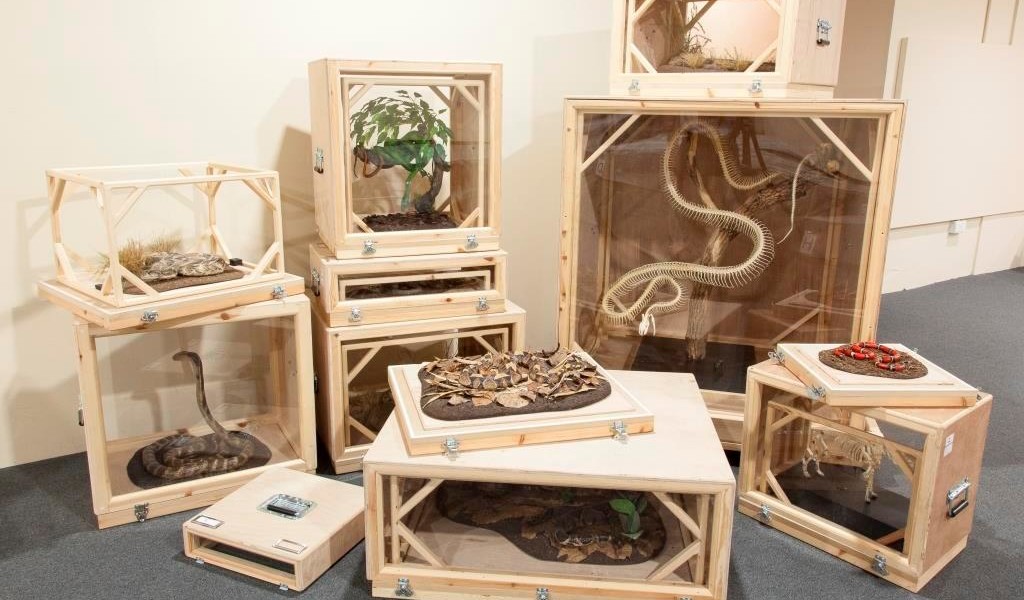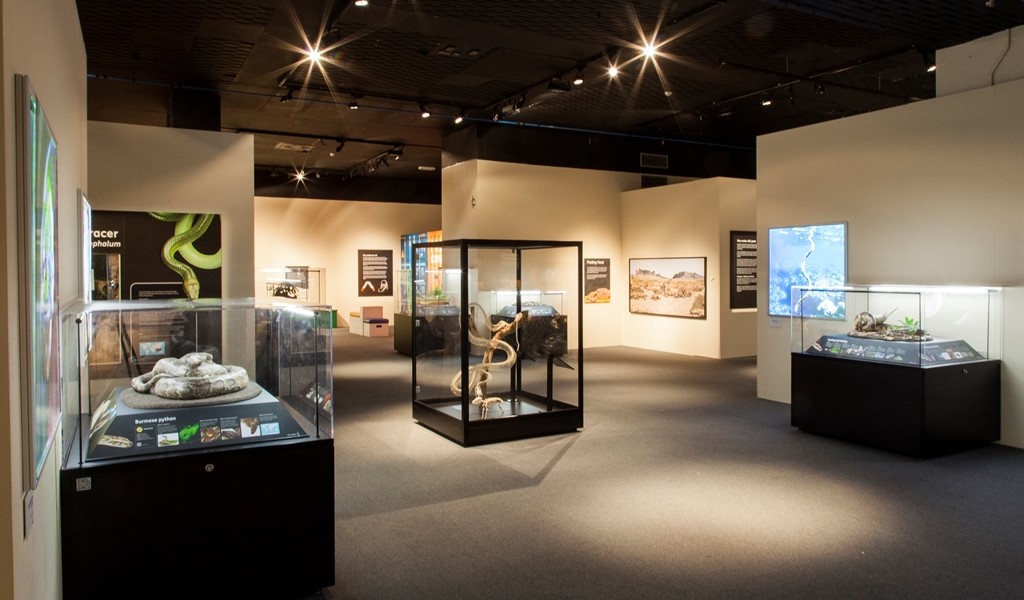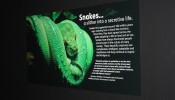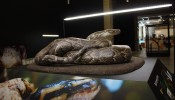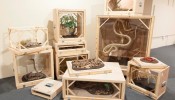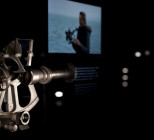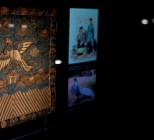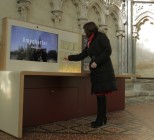Sssnakes Alive was a six month touring exhibition that drew on the expertise of Nicola Newton and Pip Strang who make up touring exhibitions company, Blue Tokay. They wanted to produce an exhibition that was natural history based, since that was their subject of interest, that would be marketable, appeal across socio-economic groups including schools (related to national science curriculum), was flexible enough to be applicable to a wide variety of venues, meet Disability Discrimination Act (DDA) standards and had a high quality to give venues value for money.
“We chose to host the Sssnakes Alive! exhibition as the subject matter was attractive to our audience at World Museum,” says Simon Brooks, Senior Designer at the World Museum. “The interpretation and clarity of the information was suited to our audience and the exhibition was fit for purpose, so met our standards of health and safety. We tend to create touring exhibitions that are more modular and easily transportable. As our exhibition space is approximately 750sqm, we tend to design exhibitions that can be flexible with the layout, so items can be taken out if going into a smaller space.”
Some of the fundamental principles of exhibition design says Brooks, are to interest, stimulate and educate the visitor in a safe, interesting and organised environment, allowing visitors to navigate easily through ‘the story’ in an informed and fruitful way.
The exhibition was built from scratch with new cases and new graphic design and dynamic interesting specimens. Blue Tokay began the build by visiting case manufacturers to hand pick the style and design they wanted. They chose cases from Framework R&D, which use high quality Perspex lids and click together bases which work well for touring. They adapted our cases to take internal lights and as the cases came with carry bags, they were easy to transport.
“We were also conscious of the need to store the exhibition at our storage unit while the exhibition wasn’t booked, so this design allows us to stack and store the cases quite easily,” says Newton. “For graphic design we wanted to have as much text as we could without overwhelming the visitor so that we could get our stories across. Science tends to need text to explain the ideas behind it. So, we decided on a decent amount of text but split into chunks around great, high quality images.”
The colours they chose were black vinyl backgrounds with white writing and they used a graphic designer to help choose fonts and sizes very carefully as they wanted the graphics to comply with DDA regulations, so venues wouldn’t have to worry about accessibility.
One problem with the cases was deciding where and how to present the graphics. We decided on graphics that would go inside the Perspex lids. We designed a type of graphic top with angled sides that could be printed on and carried as one piece.” The angle for this was derived from DDA information and presenting the graphics in this way meant that they could be viewed easily and be lit from inside the case. And added advantage of this was that being inside the case meant there was less chance of the graphics needing to be replaced due to damage.
Another very important issue was what snake specimens Blue Tokay could get to illustrate the stories. “You can’t just get your ideal wish list when it comes to taxidermy, you have to see what is available. So we went to a great taxidermist who specialises in reptiles and asked him what he had. We asked him to prepare the majority of the specimens. Our large Burmese python skeleton was prepared by a specialist who prepares skeletal mounts for many venues. Preparing a skeleton takes time as the bones need to be cleaned and rearticulated. The main issue we had with our snake specimens were the UK snakes. We had to get our smooth snake made as a model and our adder is a cast. The taxidermists simply didn’t have those specimens.”
Through a relationship with the Liverpool School of Tropical Medicine Blue Tokay obtained current, accurate information about their work and were also able to acquire specimens which would have been difficult to get hold of for taxidermy, which included a King cobra and Pit viper.
With the show at National Museums Liverpool Blue Tokay had to make the exhibition bigger than they had first intended and added more cases of material and an interactive.
National Museums Liverpool wanted to extend the exhibition to explore additional topics, and to include interactive elements for younger visitors to enjoy says Linda Brizell, Exhibitions Officer. “We produced additional content to highlight the threats of venomous snakes in tropical Africa, the work of the Liverpool School of Tropical Medicine in Africa, and the illegal trade in snake and reptile derivatives.”
The live snake displays she says also complemented the exhibition and brought the story life for visitors. “In terms of interactive elements, we designed a dress-up area with patterned walls allowing young children to explore camouflage through the use of army-style clothing against jungle and desert backdrops,” says Brizell. “We also included large floor games such as Snakes and Ladders, where players would take the place of counters using large, cushioned dice to throw and move across the board. Finally, we added in touch screens to complement a quiz which was designed to test visitors’ knowledge of the exhibition.”
The presentation says Brizell, of ‘the story’ in an organised, clear and concise way with the use of an information hierarchy, allows for various levels of understanding and engagement for the visitor. The use of entertaining and inclusive displays plus various attractive elements should be used to enliven the visitor experience she says and enhance the appearance of the environment. As well as this, the use of visitor research should inform the target audience that the exhibition is aimed at and health and safety requirements should always be priority.
“It’s essential that the content design focusses on the audience,” says Blue Tokay’s Newton. “If the audience is families, schools and other age groups, there’s no point writing text at a level of a university student.” She says the design needs to be enticing and interesting to encourage visitors and promote the business product as a brand. The exhibition design also needs to comply to the accessibility rules, as much as it can. From the point of view of the venue, the design needs to be flexible and easy to install and look after while in their care.


